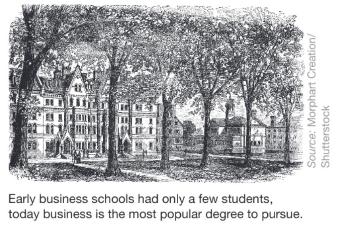Oh, but for the good old days when everything you needed to know to be a successful
Question:
Oh, but for the good old days when everything you needed to know to be a successful business manager could be contained in one book! Such was the case when J. L. Nichols, principal of the North-Western Business College in Naperville, Illinois, published The Business Guide; or Safe Methods of Business. He recommended his book as a "cheap form of full information as to methods of doing business." Or perhaps, instead of a minimum of four years of college education, you could have educated yourself completely by studying How To Do Business. Published in the late \(1890 \mathrm{~s}\), this comprehensive text contained in one volume every topic of business considered important from banking, letter writing, grammar, and mechanic's arithmetic to business geography (see the opening vignette).
The notion of the formal study of business as a separate, fully developed curriculum of undergraduate education began to take shape in 1881 with the formation of the Wharton School of Finance and Economy at the University of Pennsylvania in Philadelphia. It was the desire of Joseph Wharton, a successful financier and iron manufacturer, that with his initial \(\$ 100,000\) endowment the University of Pennsylvania develop a program of college education that would "fit for the actual duties of life . . . men other than lawyers, doctors and clergymen." Wharton's plan was that the \(\$ 6,000\) in interest earned by the \(\$ 100,000\) endowment plus \(\$ 150\) a year in tuition fees from each of 40 students would provide funds to pay the \(\$ 3,000\) salary of the dean of the business school and a \(\$ 1,500\) salary for each of the five professors, with \(\$ 1,500\) left over to buy books and provide student research grants.
The school opened with 13 students enrolled in a three year program taught by one full-time and one part-time professor. Enrollment rose to 113 by 1894, and the curriculum was expanded to four years. By 1911, all U.S. universities housed a total of 30 undergraduate business programs, and by 1925 there were 164 colleges of business. By 1960 the count was 860 , with an estimated student population of 600,000 in 1970.

When the Wharton School was founded in 1881, the U.S. labor force included 17 million workers, and over half of them had agriculture-related jobs. Employers of that time expressed the need for employees with a little knowledge of bookkeeping, some commercial geography, mathematics, and the ability to write clearly.
World War I was a turning point for business degrees. The war created more work as well as demand for greater business acumen. The economy shifted from an agricultural base to a manufacturing one. An example of this shift is the automobile industry. Automobile production became a big industry in urban areas and caused people to leave farms for the higher-paying manufacturing jobs. Consequently, to handle these more complex jobs, education became more important.
Questions
1. What do you think about going back to the "good old days" when business education was less formal and more general?
2. What changes do you think will occur within business schools in the next 10 to 20 years? What will be the basis for these changes?
3. How are business school students of today different from those in the past? What difference does this make?
Step by Step Answer:

Management Principles And Applications
ISBN: 9781942041719
4th Edition
Authors: Leonard Bierman, O.C Ferrell , Linda Ferrell





